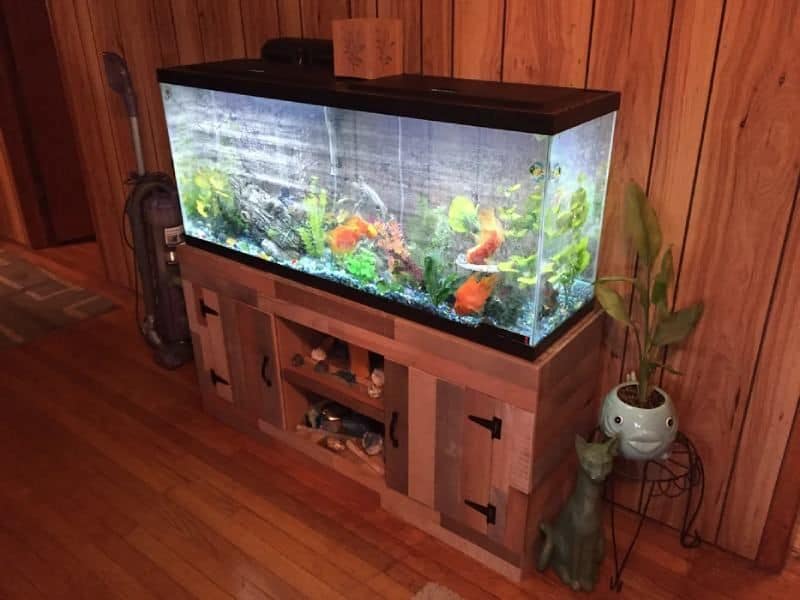An aquarium stand provides sturdy and level support for your fish tank. However, store-bought stands can be quite expensive. Fortunately, with a bit of DIY know-how, you can create an aquarium stand alternative to suit your space and budget.
Can I put my aquarium on the floor?
Putting an aquarium directly on the floor is generally not recommended. Floors can vibrate from foot traffic or settle over time, causing an unlevel tank which puts stress on the glass. The bottom of the tank also needs ventilation to prevent mold or moisture damage to flooring. For these reasons, some type of stand is ideal.
What about existing furniture?
In some cases, you may be able to safely use a table, dresser, entertainment unit, or other existing sturdy furniture to support your aquarium. Consider these factors when assessing furniture:
- Strength – Furniture must be able to hold the tremendous weight of a filled aquarium without buckling. Check weight capacities.
- Stability – Ensure the furniture has a wide, level top and does not wobble or rock.
- Ventilation – There should be open space underneath for air circulation.
- Location – Avoid high-traffic areas where bumping could occur.
- Aesthetics – Make sure the size, style and height work for optimal viewing.
Can I build my own aquarium stand?
For those handy with tools, constructing a custom stand is a cost-effective DIY project. You can build one exactly to your specifications out of wood or metal. Basic designs utilize a simple frame with four legs and bracing to prevent racking and bowing under the load.
Consider these tips for a DIY stand:
- Use very rigid construction materials like 2x4s, 2x6s, or steel tubing.
- Reinforce with triangular corner braces and cross bracing.
- Allow space between vertical supports for tank access and ventilation.
- Use a level foundation and adjust leg lengths to ensure the top is perfectly flat.
- Finish with water-resistant paint or sealant.
Creative aquarium stand ideas
Looking for an inexpensive but attractive stand solution? With a little creativity, you can upcycle all kinds of household items into a functional tank base:
| Stand Material | Preparation Tips |
|---|---|
| Crates or pallets | Screw pallets together into a tower, brace thoroughly. Use solid crates, reinforce with boards. |
| Concrete blocks | Arrange into rows and stack to desired height, use lumber bracing. |
| Bricks or pavers | Build up layers with adhesive, use rigid board on top. |
| Dresser | Ensure it’s sturdy and reinforced. Cut off legs to lower height. |
| Cabinets | Remove doors/drawers, brace internally, and seal surfaces. |
These everyday items can be transformed into an aquarium base with some DIY modifications for safety and strength. Be creative, but don’t compromise proper structural support.
Is a DIY stand safe for large aquariums?
When housing exceptionally large tanks over 75 gallons, it’s especially critical to provide a robust, non-flexing stand. A homemade stand may be suitable, provided these precautions are taken:
- Use thick, steel construction or doubled-up lumber dimensions.
- Incorporate plenty of triangular bracing for rigidity.
- Check levelness along both length and width.
- Test stand by temporarily loading with weight before adding tank.
- Allow time for any wood to settle before filling tank.
For big tanks, an engineered metal stand is generally the safest choice. But a homemade wooden stand can potentially work if over-built. Inspect regularly for any signs of instability or stress.
What about using cinder blocks?
Stacking cinder blocks is a quick and cheap way to support an aquarium, but this option has some caveats:
- Irregularities in blocks can hinder levelness.
- Shims may be needed to stabilize.
- Sealing blocks is required to prevent moisture damage.
- Bracing should be added for tanks over 40 gallons.
- Painting blocks improves aesthetics.
With extra effort taken to brace, shim, and seal the blocks, this utilitarian option can provide a sturdy base. But for larger setups, reinforced concrete or wood stands are generally better choices.
Can I use a piece of furniture?
Turning an existing furniture piece into an aquarium stand can save money, but suitability depends on these factors:
- Strength – Sturdy hardwoods like oak are best. Particle board is prone to water damage.
- Structure – Intact furniture with a solid top and four legs is ideal. Reinforce as needed.
- Levelness – Adjust or shim any wobbly legs to create a flat surface.
- Size – Make sure the footprint provides full support beneath the tank.
- Ventilation – There should be airflow space underneath.
Carefully assess an existing dresser, table, TV stand, etc before using it to hold an aquarium. Refinishing or reinforcing the piece may be required to make it suitably strong and stable.
Can I set the tank on a wooden platform?
A simple DIY wood platform can support a small to medium sized aquarium, with proper construction:
- Use moisture-resistant wood like pine or cedar.
- Minimum 2×4 framing with close joist spacing.
- Plywood top at least 3/4″ thick.
- Cross braces prevent racking.
- Shim as needed to level.
- Allow finish to fully cure before adding tank.
The platform must be very rigid and reinforced to prevent any flexing under the considerable weight. But this can provide an inexpensive stand option with minimal tools required.
Conclusion
With some smart planning and effort, you can create a stand-in for an aquarium stand using common household items or basic lumber. Carefully assess weight capacities, reinforce as needed, and test thoroughly before placing your tank. Although not quite as sturdy as a purpose-built stand, a creative DIY solution can sufficiently and safely support your aquarium while accommodating your space and budget. Just be sure not to skimp on structural support, especially for large tanks, to prevent catastrophic failure.


